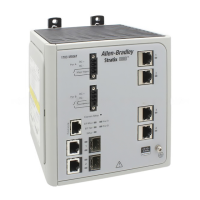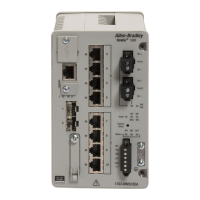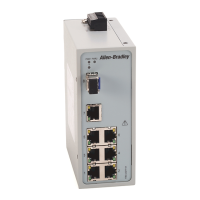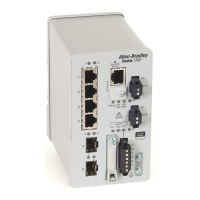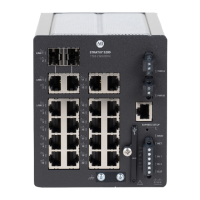Rockwell Automation Publication 1783-UM003G-EN-P - December 2012 43
Switch Software Features Chapter 2
You should configure REP only in networks with redundancy. Configuring REP
in a network without redundancy causes loss of connectivity.
Link Integrity
REP does not use an end-to-end polling mechanism between edge ports to verify
link integrity. It implements local link failure detection. The REP Link Status
Layer (LSL) detects its REP-aware neighbor and establishes connectivity within
the segment. All VLANs are blocked on an interface until it detects the neighbor.
After the neighbor is identified, REP determines which neighbor port should
become the alternate port and which ports should forward traffic.
Each port in a segment has a unique port ID. The port ID format is similar to
that used by the spanning tree algorithm: a port number (unique on the bridge),
associated to a MAC address (unique in the network). When a segment port is
coming up, its LSL starts sending packets that include the segment ID and the
port ID. The port is declared as operational after it performs a three-way
handshake with a neighbor in the same segment.
SNMP
The switch supports Simple Network Management Protocol (SNMP) versions 1,
2C, and 3. SNMP allows the switch to be remotely managed through other
network management software. This feature is disabled by default.
SNMP is based on three concepts:
• SNMP managers (client software)
• SNMP agents (network devices)
• Management Information Base (MIB)
Refer to
Supported MIBs on page 44 for the MIBs supported on the
switch.
The SNMP manager runs SNMP management software. Network devices to be
managed, such as bridges, routers, servers, and workstations, have an agent
software module. The agent provides access to a local MIB of objects that reflects
the resources and activity of the device. The agent also responds to manager
commands to retrieve values from the MIB and to set values in the MIB. The
agent and the MIB are on the switch. To configure SNMP on the switch, you
define the relationship between the manager and the agent.
Both SNMPv1 and v2C use a community-based form of security. SNMP
managers can access the agent MIB through passwords referred to as community
strings. SNMPv1 and v2C are generally used for network monitoring without
network control.
SNMPv3 provides network monitoring and control. It provides secure access to
devices by a combination of authenticating and encrypting packets over the
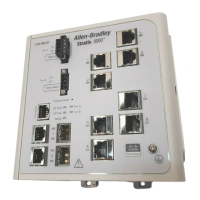
